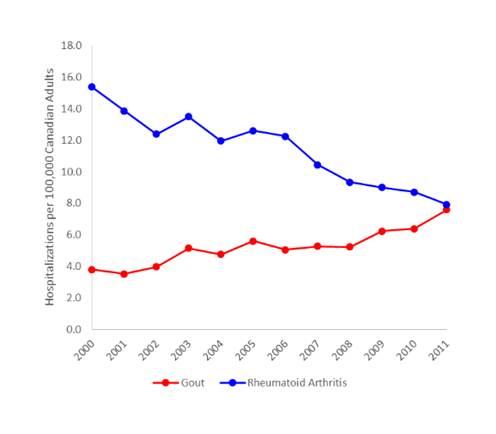Session Information
Date: Tuesday, November 15, 2016
Title: Metabolic and Crystal Arthropathies - Poster II: Epidemiology and Mechanisms of Disease
Session Type: ACR Poster Session C
Session Time: 9:00AM-11:00AM
Background/Purpose: Gout and rheumatoid arthritis (RA) are the two most common forms of inflammatory arthritis worldwide. As hospitalizations for both conditions lead to substantial health resource use, contemporary inpatient trends and associated costs may provide important benchmarks of disease burden. However, relevant data are limited. We evaluated contemporary hospitalization trends for gout and RA in a Canadian general population context.
Methods: We used PopulationData BC, a population-based dataset spanning the entire Canadian province of British Columbia. We included patients at least 18 years of age who were hospitalized from 2000-2011 with a principal diagnosis of either gout (ICD-9-CM 274 or ICD-10-CA M10) or RA (ICD-9-CM 714 or ICD-10-CA M05 or M06). We calculated annual rates of hospitalizations (expressed per 100,000 Canadian adults) for gout and RA. We assessed the trend of total hip and knee replacements among study patients. We evaluated the inpatient economic burden for both conditions. Costs were inflation-adjusted to 2011 Canadian dollars. We assessed all annual trends using Poisson and linear regression models.
Results: From 2000 to 2011, the annual hospitalization rate for those with a principal diagnosis of RA declined by 49% from 15.4 to 7.9 per 100,000 Canadian adults (p<0.001), whereas that for gout increased by 100% (i.e., doubled) from 3.8 to 7.6 per 100,000 Canadian adults (p<0.001) (Figure). Thus, at the beginning of the study period, hospitalizations for RA were approximately 4 times more frequent than those for gout; however, these opposing trends of the two conditions led to similar hospitalization rates by 2011 (i.e., 7.9 and 7.6 per 100,000 Canadian adults for RA and gout, respectively). Approximately 31% of hospitalizations with a principal diagnosis of RA were associated with total hip or knee replacement. From 2000 to 2011, the rate of these surgeries in patients with a principal diagnosis of RA decreased from 3.8 to 2.9 per 100,000 Canadian adults (p=0.0097). In contrast, less than 1% of hospitalizations with a principal diagnosis of gout were associated with total hip or knee replacement. The inflation-adjusted inpatient costs associated with a principal diagnosis of gout more than doubled over the study period from $19,426 to $43,783 (2011 CAD) per 100,000 Canadian adults (p<0.001), whereas those for RA decreased by 40% from $103,314 to $62,348 per 100,000 Canadian adults (p=0.0023) over the same period.
Conclusion: Our findings indicate that hospitalization rates for gout have doubled over the past decade, while those for RA have decreased considerably. While these data provide an encouraging benchmark for RA care, they also highlight the critical need to improve gout management and prevention to mitigate its rising disease burden in Canada and beyond. 
To cite this abstract in AMA style:
Rai SK, Avina-Zubieta JA, McCormick N, De Vera MA, Lacaille D, Sayre EC, Choi HK. Trends in Gout and Rheumatoid Arthritis Hospitalizations in Canada from 2000-2011 [abstract]. Arthritis Rheumatol. 2016; 68 (suppl 10). https://acrabstracts.org/abstract/trends-in-gout-and-rheumatoid-arthritis-hospitalizations-in-canada-from-2000-2011/. Accessed .« Back to 2016 ACR/ARHP Annual Meeting
ACR Meeting Abstracts - https://acrabstracts.org/abstract/trends-in-gout-and-rheumatoid-arthritis-hospitalizations-in-canada-from-2000-2011/
